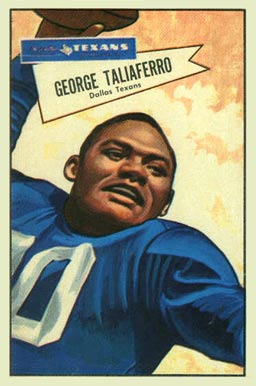George Taliaferro facts for kids

Taliaferro on a 1952 Bowman football card
|
|||||||||||||
| No. 20, 24 | |||||||||||||
|---|---|---|---|---|---|---|---|---|---|---|---|---|---|
| Position: | Halfback Quarterback |
||||||||||||
| Personal information | |||||||||||||
| Born: | January 8, 1927 Gates, Tennessee, U.S. |
||||||||||||
| Died: | October 8, 2018 (aged 91) Mason, Ohio, U.S. |
||||||||||||
| Height: | 5 ft 11 in (1.80 m) | ||||||||||||
| Weight: | 196 lb (89 kg) | ||||||||||||
| Career information | |||||||||||||
| High school: | Gary Roosevelt (Gary, Indiana) | ||||||||||||
| College: | Indiana | ||||||||||||
| NFL Draft: | 1949 / Round: 13 / Pick: 129 (by the Chicago Bears) |
||||||||||||
| Career history | |||||||||||||
|
|||||||||||||
| Career highlights and awards | |||||||||||||
| Career NFL statistics | |||||||||||||
|
|||||||||||||
| Player stats at PFR | |||||||||||||
|
College Football Hall of Fame
|
|||||||||||||
George Taliaferro (January 8, 1927 – October 8, 2018) was an amazing American football player. He made history as the first African American to be drafted by a National Football League (NFL) team.
George started his football journey at Indiana University. He later played professionally for several NFL teams. These included the New York Yanks, Dallas Texans, Baltimore Colts, and Philadelphia Eagles. In 1981, his incredible college career earned him a spot in the College Football Hall of Fame.
Contents
Early Life
George Taliaferro was born in Gates, Tennessee. When he was younger, his family moved to Gary, Indiana. He attended and graduated from Gary Roosevelt High School in Gary.
Football Career
College Football Success
From 1945 to 1948, George played for Indiana University in Bloomington, Indiana. He was a very versatile player. He could play as a halfback, quarterback, defensive back, and even a kicker!
During his time at Indiana, George faced challenges because of his race. For example, he was not allowed to live in the dorms. Despite these difficulties, he excelled on the field.
In his first year, 1945, George led the Hoosiers team to an undefeated Big Ten Conference championship. This was the only time the Hoosiers achieved this. He also led the Big Ten in rushing yards that year. This was a first for an African American player in the conference.
George was named an All-American three times. He helped break down racial barriers in sports. This happened two years before Jackie Robinson played for the Brooklyn Dodgers. In 1981, George was honored by being inducted into the College Football Hall of Fame.
Making History in the NFL
In 1949, the Chicago Bears picked George in the NFL Draft. This made him the first African American player ever drafted by an NFL team. However, George chose to play for the Los Angeles Dons in the All-America Football Conference (AAFC) instead.
He played one season with the Dons. He showed his amazing skills as a runner, passer, and punter. He was even named to the 2nd Team of the All-AAFC Team.
When the AAFC league ended, George joined the NFL in 1950. He played for the New York Yanks. He continued to show his versatility. He rushed, caught passes, and even threw touchdowns. He was a key player for the Yanks.
In 1951, George had a fantastic season. He led the league in kick returns. He was also selected for the Pro Bowl. This is a special game for the best players in the league. He was chosen for the Pro Bowl three times in his career.
After the Yanks, George played for the Dallas Texans in 1952. He then moved to the Baltimore Colts from 1953 to 1954. He continued to be a strong rusher and receiver. He also played quarterback when needed. His final season was in 1955 with the Philadelphia Eagles.
George Taliaferro was known for his ability to play many different positions. He was a true all-around football player.
Life After Football
After his football career, George Taliaferro continued to make a difference. He earned a master's degree in social work. He taught at the University of Maryland. He also became the dean of students at Morgan State University.
Later, he returned to Indiana University as a professor. He also helped start the Big Brothers Big Sisters program in South Central Indiana. He volunteered with Big Brothers Big Sisters in Baltimore too. He also helped prisoners adjust to life after release.
George's wife, Viola, was also very accomplished. She became a judge in Monroe Circuit Court. They had four children together. George remained a big sports fan and enjoyed playing golf.
Death
George Taliaferro passed away on October 8, 2018, at the age of 91. He died in Mason, Ohio, from heart failure.
See also
- Racial issues faced by black quarterbacks

